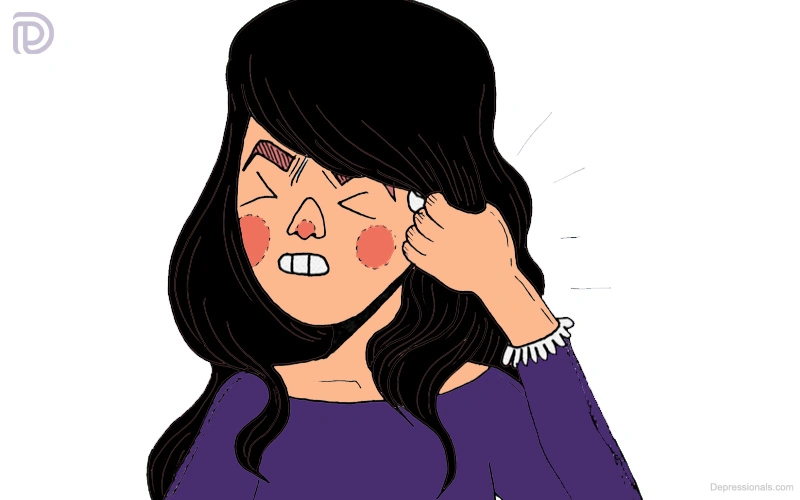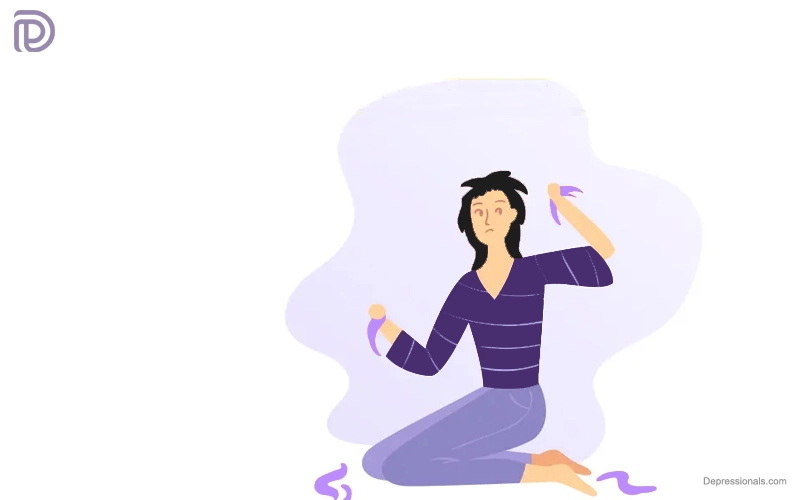Trichotillomania, or trich, is an impulse control disorder characterized by compulsive pulling of the hair, usually from the scalp, eyelashes, and eyebrows. People with trich know pulling their hair can have adverse effects, but they can’t resist the impulses.
Trichotillomania belongs to a group of body-focused repetitive behavior in which affected people cause damage to their bodies. Two people suffering from trich will not show identical symptoms. They will differ in the location they focus on, the intensity, and their response to treatment.
When the hair-pulling begins before the age of six, the condition may go away on its own. However, cases of trich that persist for a longer time tend to be more challenging to treat. Patients may experience trich in cycles — with symptoms fluctuating in intensity, disappearing, then recurring.
Read: Excoriation Disorder
How many suffer from trichotillomania?
Around 1 in 50 people suffer from trichotillomania in their lifetime. While it’s most common in children and teens, it can also affect adults. Adult females are more likely to have it, with only 10-20% of the cases being reported by males.
Difference between trichotillomania and obsessive-compulsive disorder
There are some key differences between TTM and OCD that make it a subcategory of obsessive-compulsive disorder.
- Obsessions. People with OCD experience obsessions, which are uncontrollable thoughts or urges that they do not want or can’t control. Obsessions are not involved in TTM.
- Rewarding feeling. The sensation of relief or other positive emotions is often experienced by people with TTM when they pull out their hair. Positive feelings do not play a part in OCD.
What are the effects of this condition on my body?
It is common for people with TTM to pull out one strand of hair at a time. Hair is commonly pulled from the same part of the body by many people. There are several common places people pull hair, including the scalp, the eyelashes and eyebrows, and the pubic area.
It is also important to keep in mind the age at which trichotillomania occurs when determining its effects. This behavior is often used by children as a means of self-soothing. The negative effects of this behavior are often short-lived and children don’t have long-term consequences. These conditions tend to affect adolescents, teenagers, and adults more severely compared to children and adults.
Mental health effects
TTM patients commonly experience anxiety, embarrassment, or shame as a result of their condition. They may experience difficulties at work and in social settings as a result. People who suffer from this condition are often embarrassed or ashamed of seeking treatment.
Trichophagia
The Greek word “trichophagia” means eating hair (from “tricho” for hair and “phagia” for eating) is found in about 20% of people with this condition. Their digestive tract can become blocked with hairball-like obstructions as a result. They can sometimes cause serious damage that requires surgery to repair.
The majority of people who have TTM do not inform their healthcare providers about it, even after they have disclosed details about it to them. Often, they wait until they feel more comfortable trusting their provider before sharing such sensitive information.
Tissue, hair and skin damage
When pulling out their hair, people often cause damage to their skin and tissue just beneath the surface of the skin, especially with tools like tweezers. It is sometimes necessary to repair skin damage or to perform skin grafting to treat tissue damage. Occasionally, hair pulling can result in permanent hair loss in areas that have been damaged by the procedure.
Trichotillomania symptoms and signs
The Diagnostic and Statistical Manual of Mental Disorders, Fifth Edition classifies trichotillomania under “Obsessive-Compulsive and Related Disorders.” According to the manual, the diagnostic criteria for trichotillomania include:
- Repetition of hair pulling that results in major hair loss
- Repetitive attempts to stop or curb the behavior
- Significant difficulty functioning socially, occupationally, or in other areas
- Can’t be attributed to substance abuse or a medical condition such as dermatological
- Can’t be better attributed to another psychiatric disorder
Trichotillomania complications
Depending on the intensity, people may consider trichotillomania a mild problem or a distress-causing disorder with serious complications. Common physical complications of trich may include itchy skin, tissue damage, infection and repetitive motion injuries.
Mentally, trich patients may develop low self-esteem and frequent feelings of shame and embarrassment. These feelings may result in social isolation and make them susceptible to co-occurring psychiatric disorders. The condition may strain relationships and render the patient unable to keep an occupation.
Read: Lip Biting
What causes trichotillomania?
What causes trichotillomania still hasn’t been figured out. However, some factors may increase one’s likelihood of developing the disorder. As mentioned, the disorder is most common in children or younger teens (ages 10 to 13).
Genes may also play a role as the likelihood of having trichotillomania has been shown to be passed on in some families. A person is more likely to develop the disorder if a family member has it.
Stress may trigger trichotillomania, especially at extreme levels. People who are often exposed to stressful events such as conflicts, abuse, death of a loved one, financial problems, and chronic illness may be at higher risk of suffering from trich.
It’s also believed that trichotillomania may be caused by an imbalance of brain chemicals called neurotransmitters, such as serotonin and dopamine.
Trichotillomania treatment
Treating trichotillomania is often done through cognitive-behavioral therapy (CBT). The effectiveness will be different in every patient and it’s more challenging when the trich has been persisting for a long time before the start of treatment.
CBT is habit-reversal training done to help a patient replace a harmful behavior with one that isn’t. CBT typically involves:
- Keeping a journal of hair pulling
- Determining the triggers and creating ways to work around them
- Substituting an unharmful action to hair pulling
- Getting emotional support and encouragement from loved ones
Aside from CBT, other ways of treating trichotillomania are acceptance and commitment therapy and cognitive therapy. In acceptance and commitment therapy, trich patients learn to accept the urges to pull their hair without actually pulling it. In cognitive therapy, patients are assisted in discovering the beliefs that lead to hair pulling and how to change them.
While there are no FDA-approved medicines for trichotillomania, there are drugs that help manage its symptoms, such as anti-depressants, atypical antipsychotics and N-acetyl-cysteine.
Read: How to Stop Trichotillomania
Living with trichotillomania
There is no proven way to 100% safeguard yourself from trichotillomania. But if you are suffering from it, you should seek treatment as soon as possible. Aside from seeking professional help, developing a healthy self-care habit will help alleviate the symptoms.
Since stress is a known trigger of trichotillomania, you should learn healthy coping strategies. You can’t avoid stress, so knowing how to minimize its effects on you will go a long way. Determine what things stress you the most and learn how you can avoid or work around them.
Women often experience stress and anxiety during their period. They should employ techniques that will help them distress, such as getting a massage, meditating, drinking tea, and avoiding alcohol and caffeine.
One of the best ways to reduce stress is to take a break from the things that cause it and invest time doing the things you enjoy. You should allocate time in your daily routine for your hobbies, be it dancing, painting, writing, reading, or playing video games. The less stressed you are, the less likely you can be triggered to pull your hair.
Trichotillomania isn’t a common mental disorder, but it doesn’t mean your life is ruined if you get it. Treatment such as CBT is effective, especially when started early. If you help yourself and accept support from friends and family, trichotillomania will be a lot more manageable, and you are more likely to get through it.



I do agree with all of the ideas you have presented in your post. They are really convincing and will certainly work.
Thank you for sharing excellent informations. Your web site is very cool. I am impressed by the details that you’ve on this web site. It reveals how nicely you understand this subject. Bookmarked this website page, will come back for more articles. You, my pal, ROCK! I found just the info I already searched all over the place and simply couldn’t come across. What a great site.
Nice read, I just passed this onto a friend who was doing a little research on that. And he just bought me lunch since I found it for him smile So let me rephrase that: Thank you for lunch! “We steal if we touch tomorrow. It is God’s.” by Henry Ward Beecher.